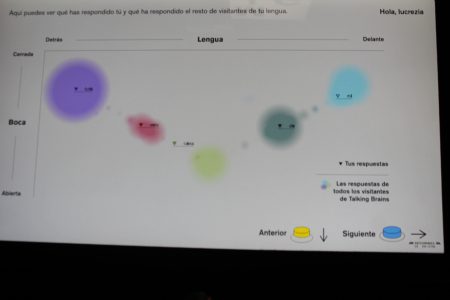Talking brains at Cosmocaixa in Barcelona is the exhibition that I enjoyed the most over the past six months. I visited it in an extremely quiet moment, at about 2 pm on a Wednesday without what I believe must be the regular nightmare: storms of highschool students or hoards of families. I instead had the whole space for myself. The exhibition is pretty catchy and simple, as it deals with basic questions anyone asks her/himself at some point: how does the faculty of talking work? How do kids learn to talk? And so on. But thankfully it goes further. And there it is when it spreads its wings.
Cosmocaixa cooperated with University Pompeu Fabra, University of Barcelona and ICREA (Catalan Institute of Research and Advanced Studies) for the project, and it was beyond interesting to see the results.
The visit really gave me the opportunity of experiencing in the same place so many different practices that are currently being put in place or discussed in contemporary exhibitions and I was delighted by it.
I would like to refer to user generated content – in specific way -, virtual reality and individual visitors experiences.
The user generated content & the individual visitors experience of Talking Brains
In Talking Brains each visit is different from any other. Besides some introductory panels at the beginning of the sections, there is not much shown to the eye of the lazy visitor. Talking Brains requires the visitors to constantly interact with what the curators have planned: the content is actually hidden, and will be partially generated, or better said, uncovered, by the actions performed by each visitor.

“Hola Lucrezia” – reaction times comparison between my results and the average of visitors regarding mistaken heard in spoken sentences (I am slow but accurate 😉 )
All are given the possibility of shaping their own educational activity throughout the whole exhibition thanks to a chip card that they can customized at the beginning of the visit with their name. Thanks to this, the visitors will be greeted in their preferred language (Spanish, Catalan, French and English are available) at each “station” of the visit, where they can interact with the content, whether by pushing buttons to highlight a map or answering questions.
This way each experience becomes literally unique and “labeled” for me without needing to refer to transcendental or perceptional differences in a complex way: no, my visit will necessarily be unique because I will answer some questions in a different way and my learning experience will therefore tailored based.
For an exhibition dedicated to something so complex and the nature of which is still being researched such as the language, I think it was a perfect decision.
Virtual reality in an exhibition context
I was really thrilled when I put on the glasses – helmet, it had been months that I had wanted to use a pair and I watched the short documentary on how the brain is shaped after birth even twice with a very stupid smile on my face because of said thrill. Still. I do not think it really added anything to the exhibition, and it could have lived without it, since apart from the very beginning (when millions of spermatozons are reaching an egg from EVERYWHERE around you, something I genuinely mistook for a representation of the Big Bang at first and asked myself what was that) and the end, it is not even particularly representative of it. In my opinion it was more show off than anything but still…fun for me (link)
The content of the exhibition
If the first part of the visit was quite boring for me in regard to its content (focussing on how learning processes etc.), I became the most excited person around towards the end, where the curators staged a brilliant series of cognitive exercises that challenged our brains. Here visitors are faced with much more complex tasks that are (if I remember correctly) never right or wrong but are only aimed to show how the brain works when it is requested to perform some activities, for example identifying pronounced vowels through headphones, remembering sequence of spoken words, suggesting the first word that comes to one’s mind after being shown another word and so on. And all the answers the visitors gave before yours are visible at the end of each step and displayed via graphs, charts, maps that show average answers in your language and in general. Brilliant.

Comparison between my answers and all visitors’ ones regarding the matching of spoken vowels and displayed ones (phones and graphems)

Comparison between visitors’ answers on phonetics with the variable of the mother tongue

Semantic fields – my speed and that of the other visitors at answering
I do not know how many visitors the exhibition had, but I can only estimate several hundreds, as there are agreements between Barcelona’s schools and Cosmocaixa. Anyway, it is clear that this is a huge amount of wonderful data to use.

The intro to the cognitive maps

Beneficio, hotel, Pues, and Postal were the words that the system proposed to me.

the dream
I asked already several weeks ago what would be done with this material, not because I am afraid of Google nor such things, but because it would be just F A N T A S T I C to see the results at least of those beautiful cognitive maps published outside of the academic circles.
I had no answers, I still hope they are going to do something out of it and that it will be of public use.
All pictures (as bad as they are) are mine.
Pic: the end of the exhbition – transdisciplinarity is regarded as the key.
